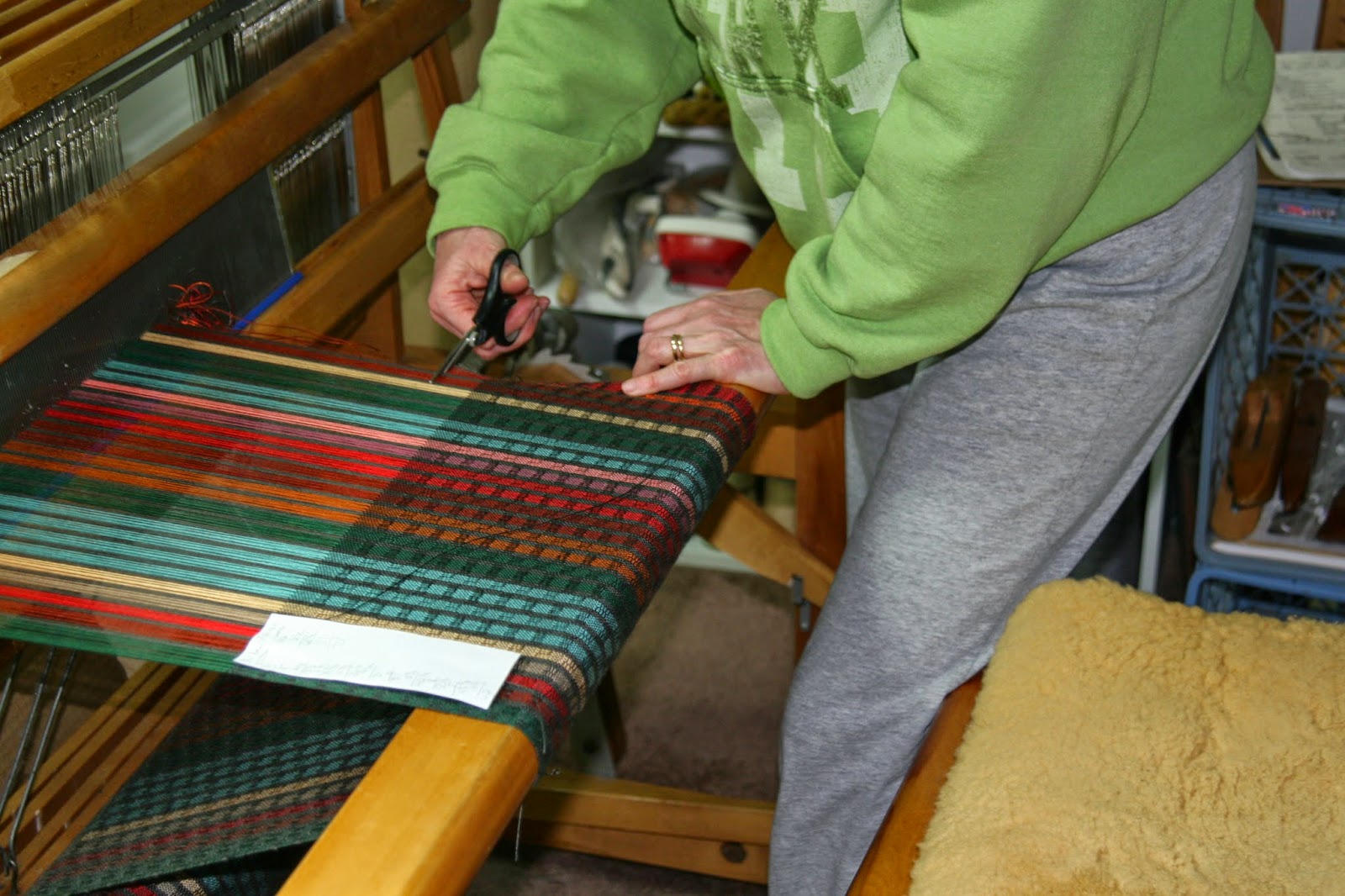Now I begin the fun task of choosing the weft color--the thread on the bobbin in the shuttle above, that is thrown back and forth, interlacing with the warp on the loom. It is throwing the shuttle, in combination with pressing the foot treadles, that actually constructs the woven web of fabric. I always include at least 18" of extra warp when I plan a project so I have room for sampling various weft colors and treadling patterns that would change the appearance of the fabric. I'm often surprised at how the weft color changes the appearance of the warp. In this case, the customer who ordered this wrap specified a dark gray for the weft, so that decision was made. In the photo below you can just make out a couple of different treadling patterns I tried, with the Ms and Os pattern closest to the bottom being the one I used.
I always weave with my shoes off--allows my feet to feel the treadles and move between them more smoothly.
As I press the treadles in sequence, the shafts of my counterbalance loom raise and lower, and a shed opens--the space between the raised and lowered warps--into which I throw the shuttle. For this Ms and Os pattern, with the threading and tie-up I'm using, the treadling sequence is 16161616 53535353. Even though my loom has six treadles, to make this pattern I need only use four.
And that's how it's done, over and over again. For this piece, I wove about 72" with 20 picks, or throws of the shuttle depositing one weft thread, per inch. About 1400 throws of the shuttle in all, taking about 3 hours. I usually break up the weaving into shorter sessions spread over a few days to save wear and tear on my arms and shoulders.
After each pick, I grab the beater containing the reed and pull it against the fabric, pushing that just-woven thread up against the fabric underneath it. I have to use a consistent beat in order for the woven density of the fabric to be even --if I beat more gently some times and more firmly at other times, it shows in the fabric as looser and tighter sections, and I've learned the hard way that it can't be repaired later. A consistent beat is something that comes with hours of practice and with maintaining a regular rhythm in treadling, throwing the shuttle, and pulling the beater. It's physical work, but it's rhythmical too, a bit like dancing. Once your hands and feet learn the dance, your mind is free to wander a bit, if the treadling pattern is not too complex. Of course if your mind wanders too far you make mistakes.
I also keep an eye on the edges, or selvedges of the fabric, where the weft thread wraps around the edge warp thread before making its return trip across the fabric. I want to make sure the selvedges don't draw in too much, or have loose loops of fabric protruding. Loops can be fixed, laboriously, but draw-in cannot. Again, practice and an even rhythm make a huge difference here.
In the photo above where I'm using the beater, you can see a slip of paper pinned to the edge of the woven fabric--this is where I periodically record the number of inches I've woven since the start. When the woven web grows closer to the beater, I advance the warp by winding the cloth beam forward. Measuring and recording the inches I've woven as I go is the only way to know where I am in the project.
I almost never weave just one project from a warp, so I also wove another piece on this warp, using the same pattern and a black weft. Next week we'll look at how different the gray and black wefts appear against the bright stripes of the warp.
And then, when the weaving is all done, comes the hugely satisfying moment of cutting off. There is no fringe on this project, so I can cut the warp fairly close to the edge of the fabric.
You may be thinking, But there's lots of warp left on the loom! There is always a certain amount of loom waste
in a project, warp that remains unwoven. Because of the way the loom is
constructed there is no way to insert the shuttle in a shed right up to
the end of the warp . On my loom I usually allow 26" for loom waste.
These leftover warp threads are known as thrums, and weavers have
endless discussions about what to do with their thrums. For now I'm
just throwing mine in a basket where they collect dust.
And then I pull the fabric off, and it unspools from the cloth beam in, I hope, all its glory and with no glaring errors.
Remember how I tied on all those little bundles of warp ends to the front? Now they have to be untied, and the shoelaces I used as warp spreaders before I started weaving can be removed too.
Next I will machine zigzag stitch the cut edges of the fabric to keep it from raveling, and then handwash the fabric and allow it to hang dry overnight. Then I'll finish constructing the infinity wrap.
Thanks for joining me on this journey--and tune in next time to see the finished projects.
P.S. Let me know if you have any use for my thrums. Free to a good home!











No comments:
Post a Comment